Global Tourism: Key Destinations, Emerging Markets, and Growth
VerifiedAdded on 2023/01/03
|13
|3993
|68
Report
AI Summary
This report provides a comprehensive overview of the global tourism industry, encompassing its nature, trends, and key destinations. It examines the characteristics of tourist-generating and receiving areas, highlighting factors such as climate, location, social culture, and environment. The report analyzes the impact of tourism on emerging economies, evaluating the factors influencing global tourism and the reasons behind the growth of key global tourism destinations. It compares emerging destinations based on their life cycle stages, growth drivers, and strategies. Additionally, it explores the roles and responsibilities of international organizations in tourism development, along with future threats and challenges. The report concludes with recommendations for governments and international companies within the tourism sector and implications of various threats and challenges.
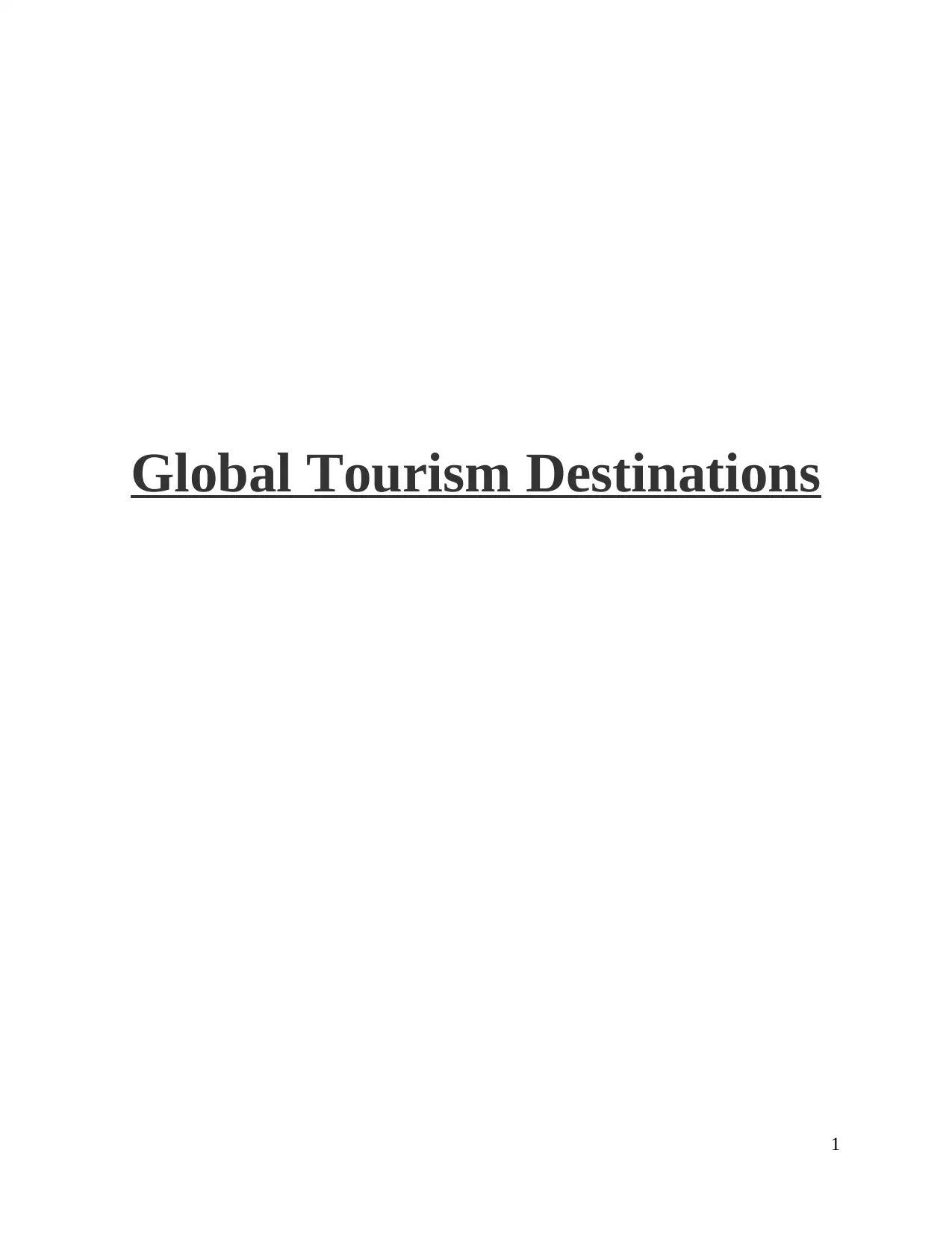
Global Tourism Destinations
1
1
Paraphrase This Document
Need a fresh take? Get an instant paraphrase of this document with our AI Paraphraser
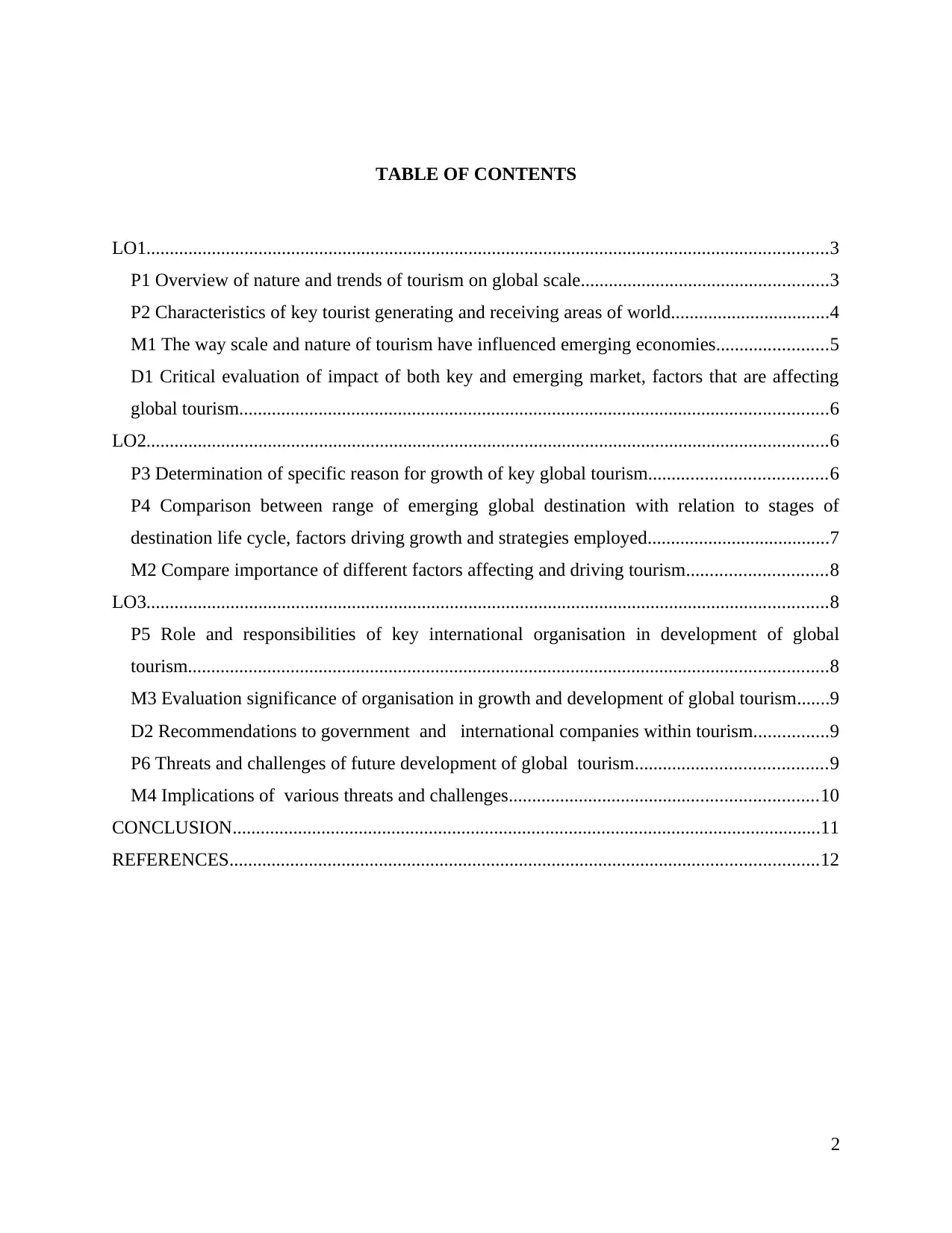
TABLE OF CONTENTS
LO1..................................................................................................................................................3
P1 Overview of nature and trends of tourism on global scale.....................................................3
P2 Characteristics of key tourist generating and receiving areas of world..................................4
M1 The way scale and nature of tourism have influenced emerging economies........................5
D1 Critical evaluation of impact of both key and emerging market, factors that are affecting
global tourism..............................................................................................................................6
LO2..................................................................................................................................................6
P3 Determination of specific reason for growth of key global tourism......................................6
P4 Comparison between range of emerging global destination with relation to stages of
destination life cycle, factors driving growth and strategies employed.......................................7
M2 Compare importance of different factors affecting and driving tourism..............................8
LO3..................................................................................................................................................8
P5 Role and responsibilities of key international organisation in development of global
tourism.........................................................................................................................................8
M3 Evaluation significance of organisation in growth and development of global tourism.......9
D2 Recommendations to government and international companies within tourism................9
P6 Threats and challenges of future development of global tourism.........................................9
M4 Implications of various threats and challenges..................................................................10
CONCLUSION..............................................................................................................................11
REFERENCES..............................................................................................................................12
2
LO1..................................................................................................................................................3
P1 Overview of nature and trends of tourism on global scale.....................................................3
P2 Characteristics of key tourist generating and receiving areas of world..................................4
M1 The way scale and nature of tourism have influenced emerging economies........................5
D1 Critical evaluation of impact of both key and emerging market, factors that are affecting
global tourism..............................................................................................................................6
LO2..................................................................................................................................................6
P3 Determination of specific reason for growth of key global tourism......................................6
P4 Comparison between range of emerging global destination with relation to stages of
destination life cycle, factors driving growth and strategies employed.......................................7
M2 Compare importance of different factors affecting and driving tourism..............................8
LO3..................................................................................................................................................8
P5 Role and responsibilities of key international organisation in development of global
tourism.........................................................................................................................................8
M3 Evaluation significance of organisation in growth and development of global tourism.......9
D2 Recommendations to government and international companies within tourism................9
P6 Threats and challenges of future development of global tourism.........................................9
M4 Implications of various threats and challenges..................................................................10
CONCLUSION..............................................................................................................................11
REFERENCES..............................................................................................................................12
2
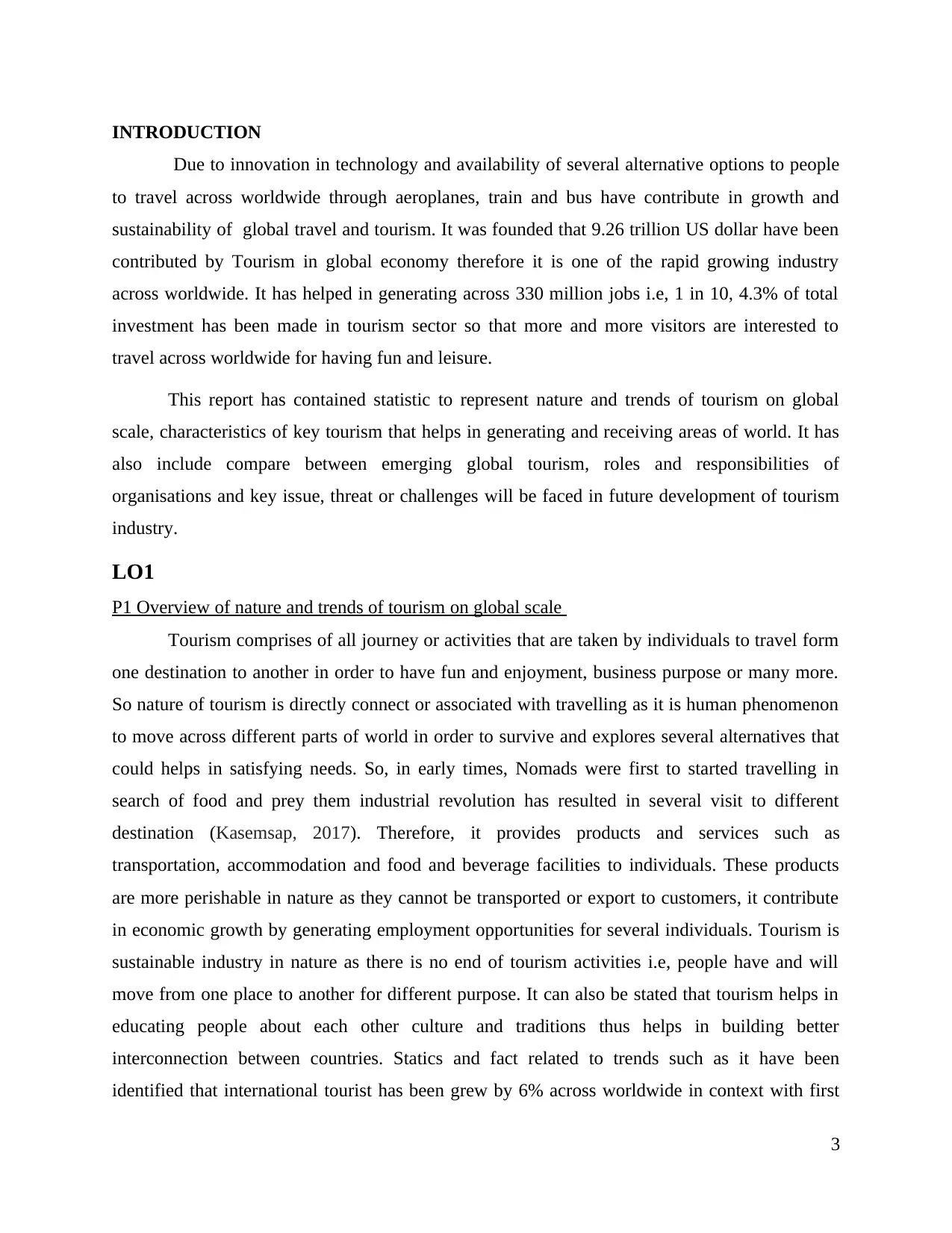
INTRODUCTION
Due to innovation in technology and availability of several alternative options to people
to travel across worldwide through aeroplanes, train and bus have contribute in growth and
sustainability of global travel and tourism. It was founded that 9.26 trillion US dollar have been
contributed by Tourism in global economy therefore it is one of the rapid growing industry
across worldwide. It has helped in generating across 330 million jobs i.e, 1 in 10, 4.3% of total
investment has been made in tourism sector so that more and more visitors are interested to
travel across worldwide for having fun and leisure.
This report has contained statistic to represent nature and trends of tourism on global
scale, characteristics of key tourism that helps in generating and receiving areas of world. It has
also include compare between emerging global tourism, roles and responsibilities of
organisations and key issue, threat or challenges will be faced in future development of tourism
industry.
LO1
P1 Overview of nature and trends of tourism on global scale
Tourism comprises of all journey or activities that are taken by individuals to travel form
one destination to another in order to have fun and enjoyment, business purpose or many more.
So nature of tourism is directly connect or associated with travelling as it is human phenomenon
to move across different parts of world in order to survive and explores several alternatives that
could helps in satisfying needs. So, in early times, Nomads were first to started travelling in
search of food and prey them industrial revolution has resulted in several visit to different
destination (Kasemsap, 2017). Therefore, it provides products and services such as
transportation, accommodation and food and beverage facilities to individuals. These products
are more perishable in nature as they cannot be transported or export to customers, it contribute
in economic growth by generating employment opportunities for several individuals. Tourism is
sustainable industry in nature as there is no end of tourism activities i.e, people have and will
move from one place to another for different purpose. It can also be stated that tourism helps in
educating people about each other culture and traditions thus helps in building better
interconnection between countries. Statics and fact related to trends such as it have been
identified that international tourist has been grew by 6% across worldwide in context with first
3
Due to innovation in technology and availability of several alternative options to people
to travel across worldwide through aeroplanes, train and bus have contribute in growth and
sustainability of global travel and tourism. It was founded that 9.26 trillion US dollar have been
contributed by Tourism in global economy therefore it is one of the rapid growing industry
across worldwide. It has helped in generating across 330 million jobs i.e, 1 in 10, 4.3% of total
investment has been made in tourism sector so that more and more visitors are interested to
travel across worldwide for having fun and leisure.
This report has contained statistic to represent nature and trends of tourism on global
scale, characteristics of key tourism that helps in generating and receiving areas of world. It has
also include compare between emerging global tourism, roles and responsibilities of
organisations and key issue, threat or challenges will be faced in future development of tourism
industry.
LO1
P1 Overview of nature and trends of tourism on global scale
Tourism comprises of all journey or activities that are taken by individuals to travel form
one destination to another in order to have fun and enjoyment, business purpose or many more.
So nature of tourism is directly connect or associated with travelling as it is human phenomenon
to move across different parts of world in order to survive and explores several alternatives that
could helps in satisfying needs. So, in early times, Nomads were first to started travelling in
search of food and prey them industrial revolution has resulted in several visit to different
destination (Kasemsap, 2017). Therefore, it provides products and services such as
transportation, accommodation and food and beverage facilities to individuals. These products
are more perishable in nature as they cannot be transported or export to customers, it contribute
in economic growth by generating employment opportunities for several individuals. Tourism is
sustainable industry in nature as there is no end of tourism activities i.e, people have and will
move from one place to another for different purpose. It can also be stated that tourism helps in
educating people about each other culture and traditions thus helps in building better
interconnection between countries. Statics and fact related to trends such as it have been
identified that international tourist has been grew by 6% across worldwide in context with first
3
⊘ This is a preview!⊘
Do you want full access?
Subscribe today to unlock all pages.

Trusted by 1+ million students worldwide
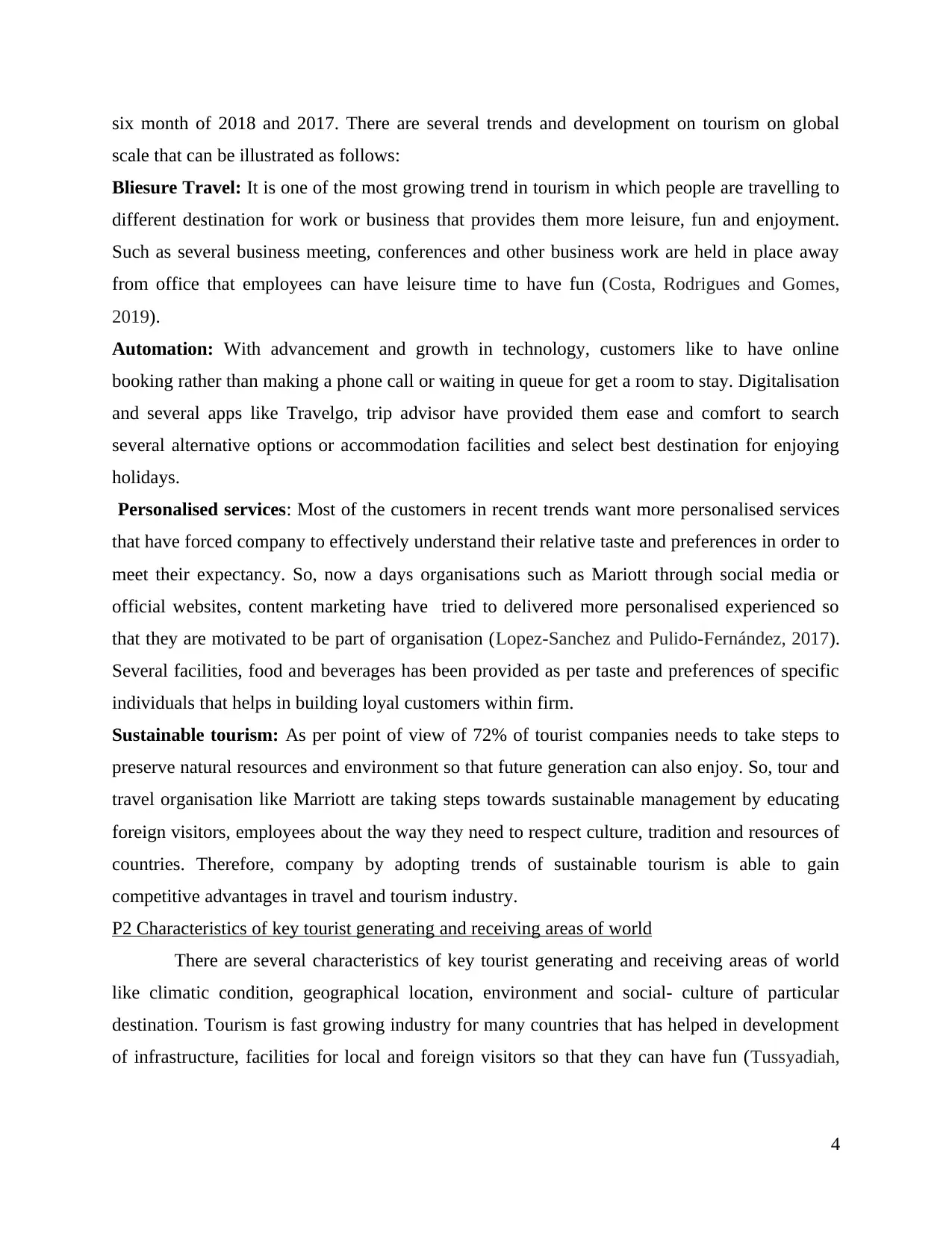
six month of 2018 and 2017. There are several trends and development on tourism on global
scale that can be illustrated as follows:
Bliesure Travel: It is one of the most growing trend in tourism in which people are travelling to
different destination for work or business that provides them more leisure, fun and enjoyment.
Such as several business meeting, conferences and other business work are held in place away
from office that employees can have leisure time to have fun (Costa, Rodrigues and Gomes,
2019).
Automation: With advancement and growth in technology, customers like to have online
booking rather than making a phone call or waiting in queue for get a room to stay. Digitalisation
and several apps like Travelgo, trip advisor have provided them ease and comfort to search
several alternative options or accommodation facilities and select best destination for enjoying
holidays.
Personalised services: Most of the customers in recent trends want more personalised services
that have forced company to effectively understand their relative taste and preferences in order to
meet their expectancy. So, now a days organisations such as Mariott through social media or
official websites, content marketing have tried to delivered more personalised experienced so
that they are motivated to be part of organisation (Lopez-Sanchez and Pulido-Fernández, 2017).
Several facilities, food and beverages has been provided as per taste and preferences of specific
individuals that helps in building loyal customers within firm.
Sustainable tourism: As per point of view of 72% of tourist companies needs to take steps to
preserve natural resources and environment so that future generation can also enjoy. So, tour and
travel organisation like Marriott are taking steps towards sustainable management by educating
foreign visitors, employees about the way they need to respect culture, tradition and resources of
countries. Therefore, company by adopting trends of sustainable tourism is able to gain
competitive advantages in travel and tourism industry.
P2 Characteristics of key tourist generating and receiving areas of world
There are several characteristics of key tourist generating and receiving areas of world
like climatic condition, geographical location, environment and social- culture of particular
destination. Tourism is fast growing industry for many countries that has helped in development
of infrastructure, facilities for local and foreign visitors so that they can have fun (Tussyadiah,
4
scale that can be illustrated as follows:
Bliesure Travel: It is one of the most growing trend in tourism in which people are travelling to
different destination for work or business that provides them more leisure, fun and enjoyment.
Such as several business meeting, conferences and other business work are held in place away
from office that employees can have leisure time to have fun (Costa, Rodrigues and Gomes,
2019).
Automation: With advancement and growth in technology, customers like to have online
booking rather than making a phone call or waiting in queue for get a room to stay. Digitalisation
and several apps like Travelgo, trip advisor have provided them ease and comfort to search
several alternative options or accommodation facilities and select best destination for enjoying
holidays.
Personalised services: Most of the customers in recent trends want more personalised services
that have forced company to effectively understand their relative taste and preferences in order to
meet their expectancy. So, now a days organisations such as Mariott through social media or
official websites, content marketing have tried to delivered more personalised experienced so
that they are motivated to be part of organisation (Lopez-Sanchez and Pulido-Fernández, 2017).
Several facilities, food and beverages has been provided as per taste and preferences of specific
individuals that helps in building loyal customers within firm.
Sustainable tourism: As per point of view of 72% of tourist companies needs to take steps to
preserve natural resources and environment so that future generation can also enjoy. So, tour and
travel organisation like Marriott are taking steps towards sustainable management by educating
foreign visitors, employees about the way they need to respect culture, tradition and resources of
countries. Therefore, company by adopting trends of sustainable tourism is able to gain
competitive advantages in travel and tourism industry.
P2 Characteristics of key tourist generating and receiving areas of world
There are several characteristics of key tourist generating and receiving areas of world
like climatic condition, geographical location, environment and social- culture of particular
destination. Tourism is fast growing industry for many countries that has helped in development
of infrastructure, facilities for local and foreign visitors so that they can have fun (Tussyadiah,
4
Paraphrase This Document
Need a fresh take? Get an instant paraphrase of this document with our AI Paraphraser
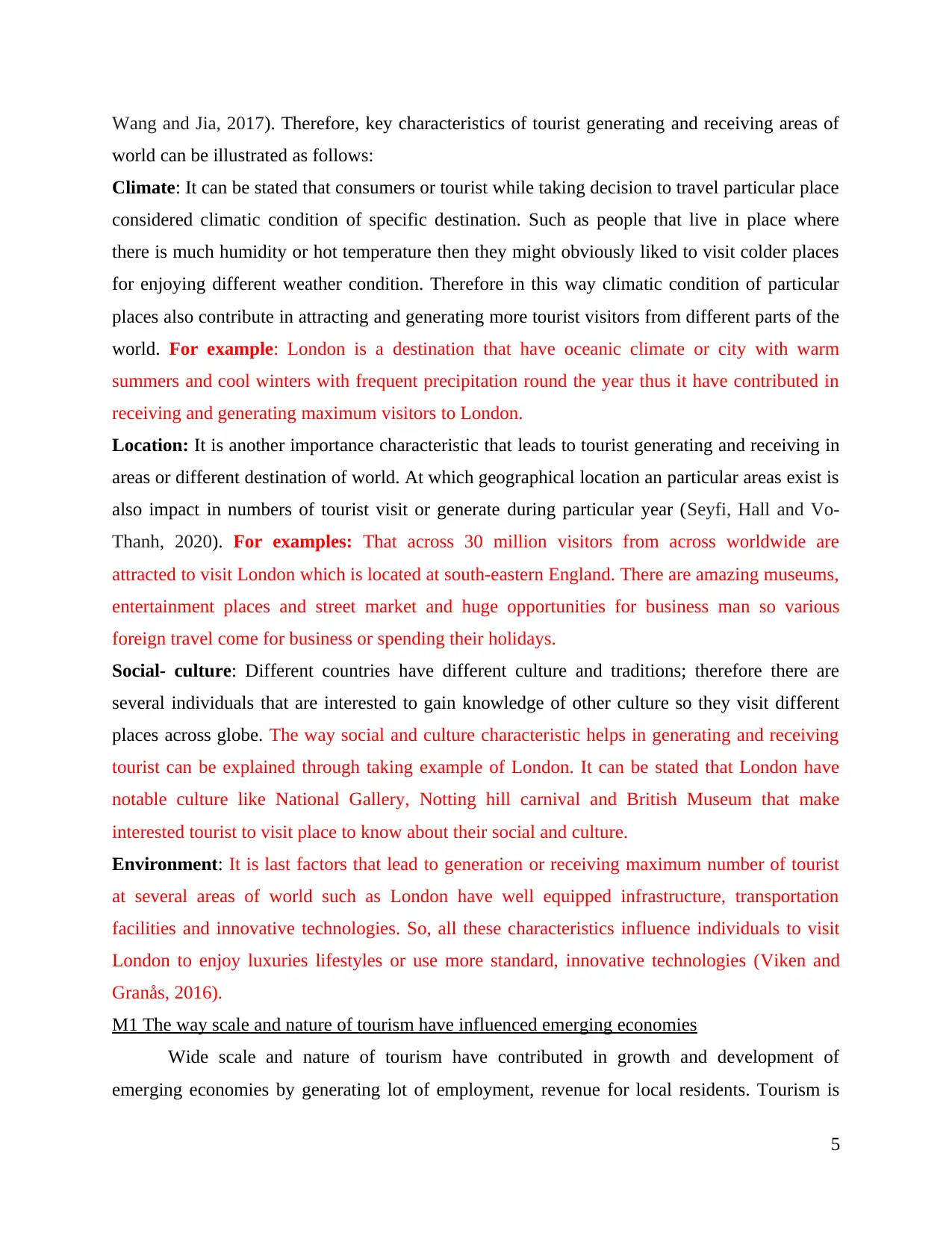
Wang and Jia, 2017). Therefore, key characteristics of tourist generating and receiving areas of
world can be illustrated as follows:
Climate: It can be stated that consumers or tourist while taking decision to travel particular place
considered climatic condition of specific destination. Such as people that live in place where
there is much humidity or hot temperature then they might obviously liked to visit colder places
for enjoying different weather condition. Therefore in this way climatic condition of particular
places also contribute in attracting and generating more tourist visitors from different parts of the
world. For example: London is a destination that have oceanic climate or city with warm
summers and cool winters with frequent precipitation round the year thus it have contributed in
receiving and generating maximum visitors to London.
Location: It is another importance characteristic that leads to tourist generating and receiving in
areas or different destination of world. At which geographical location an particular areas exist is
also impact in numbers of tourist visit or generate during particular year (Seyfi, Hall and Vo-
Thanh, 2020). For examples: That across 30 million visitors from across worldwide are
attracted to visit London which is located at south-eastern England. There are amazing museums,
entertainment places and street market and huge opportunities for business man so various
foreign travel come for business or spending their holidays.
Social- culture: Different countries have different culture and traditions; therefore there are
several individuals that are interested to gain knowledge of other culture so they visit different
places across globe. The way social and culture characteristic helps in generating and receiving
tourist can be explained through taking example of London. It can be stated that London have
notable culture like National Gallery, Notting hill carnival and British Museum that make
interested tourist to visit place to know about their social and culture.
Environment: It is last factors that lead to generation or receiving maximum number of tourist
at several areas of world such as London have well equipped infrastructure, transportation
facilities and innovative technologies. So, all these characteristics influence individuals to visit
London to enjoy luxuries lifestyles or use more standard, innovative technologies (Viken and
Granås, 2016).
M1 The way scale and nature of tourism have influenced emerging economies
Wide scale and nature of tourism have contributed in growth and development of
emerging economies by generating lot of employment, revenue for local residents. Tourism is
5
world can be illustrated as follows:
Climate: It can be stated that consumers or tourist while taking decision to travel particular place
considered climatic condition of specific destination. Such as people that live in place where
there is much humidity or hot temperature then they might obviously liked to visit colder places
for enjoying different weather condition. Therefore in this way climatic condition of particular
places also contribute in attracting and generating more tourist visitors from different parts of the
world. For example: London is a destination that have oceanic climate or city with warm
summers and cool winters with frequent precipitation round the year thus it have contributed in
receiving and generating maximum visitors to London.
Location: It is another importance characteristic that leads to tourist generating and receiving in
areas or different destination of world. At which geographical location an particular areas exist is
also impact in numbers of tourist visit or generate during particular year (Seyfi, Hall and Vo-
Thanh, 2020). For examples: That across 30 million visitors from across worldwide are
attracted to visit London which is located at south-eastern England. There are amazing museums,
entertainment places and street market and huge opportunities for business man so various
foreign travel come for business or spending their holidays.
Social- culture: Different countries have different culture and traditions; therefore there are
several individuals that are interested to gain knowledge of other culture so they visit different
places across globe. The way social and culture characteristic helps in generating and receiving
tourist can be explained through taking example of London. It can be stated that London have
notable culture like National Gallery, Notting hill carnival and British Museum that make
interested tourist to visit place to know about their social and culture.
Environment: It is last factors that lead to generation or receiving maximum number of tourist
at several areas of world such as London have well equipped infrastructure, transportation
facilities and innovative technologies. So, all these characteristics influence individuals to visit
London to enjoy luxuries lifestyles or use more standard, innovative technologies (Viken and
Granås, 2016).
M1 The way scale and nature of tourism have influenced emerging economies
Wide scale and nature of tourism have contributed in growth and development of
emerging economies by generating lot of employment, revenue for local residents. Tourism is
5
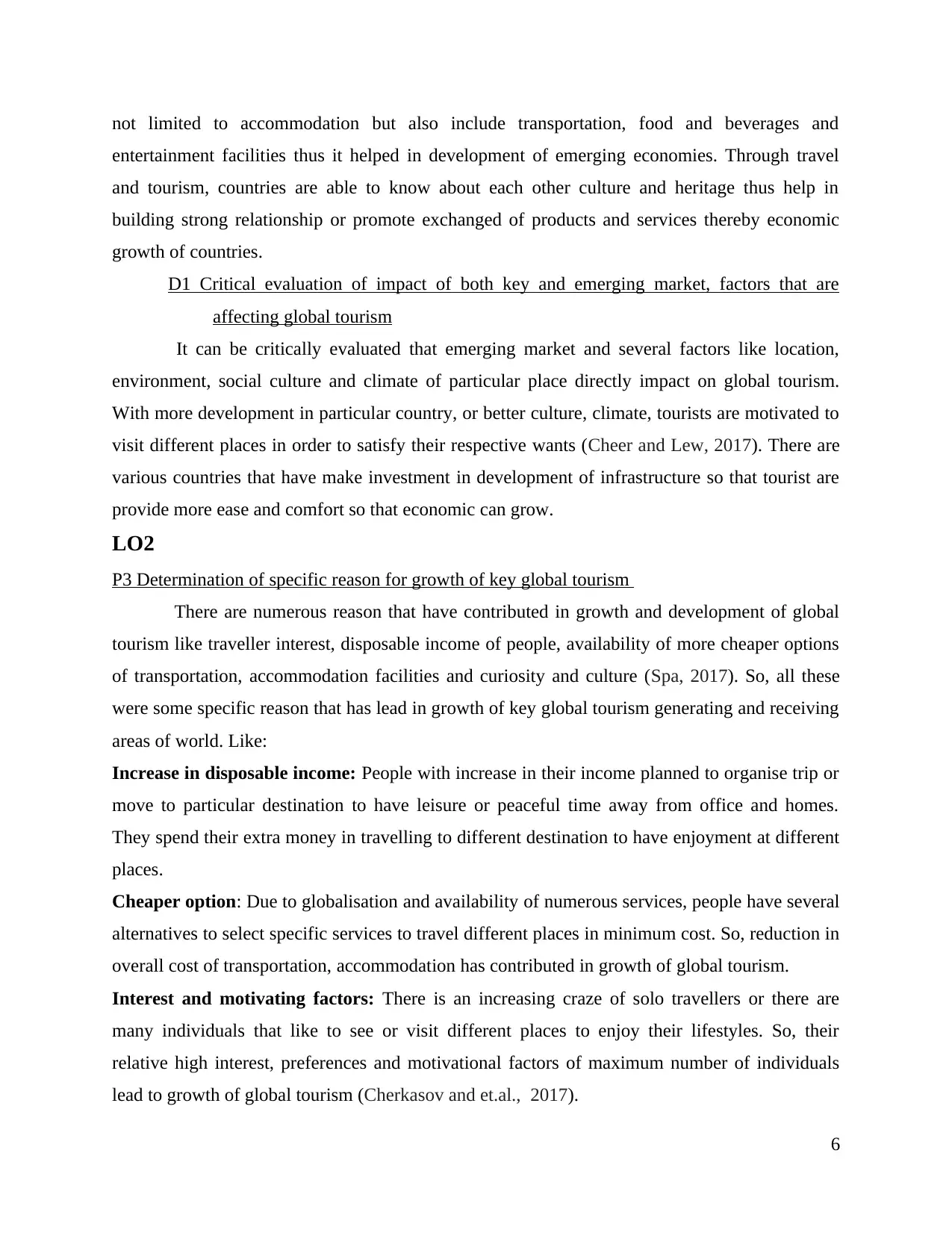
not limited to accommodation but also include transportation, food and beverages and
entertainment facilities thus it helped in development of emerging economies. Through travel
and tourism, countries are able to know about each other culture and heritage thus help in
building strong relationship or promote exchanged of products and services thereby economic
growth of countries.
D1 Critical evaluation of impact of both key and emerging market, factors that are
affecting global tourism
It can be critically evaluated that emerging market and several factors like location,
environment, social culture and climate of particular place directly impact on global tourism.
With more development in particular country, or better culture, climate, tourists are motivated to
visit different places in order to satisfy their respective wants (Cheer and Lew, 2017). There are
various countries that have make investment in development of infrastructure so that tourist are
provide more ease and comfort so that economic can grow.
LO2
P3 Determination of specific reason for growth of key global tourism
There are numerous reason that have contributed in growth and development of global
tourism like traveller interest, disposable income of people, availability of more cheaper options
of transportation, accommodation facilities and curiosity and culture (Spa, 2017). So, all these
were some specific reason that has lead in growth of key global tourism generating and receiving
areas of world. Like:
Increase in disposable income: People with increase in their income planned to organise trip or
move to particular destination to have leisure or peaceful time away from office and homes.
They spend their extra money in travelling to different destination to have enjoyment at different
places.
Cheaper option: Due to globalisation and availability of numerous services, people have several
alternatives to select specific services to travel different places in minimum cost. So, reduction in
overall cost of transportation, accommodation has contributed in growth of global tourism.
Interest and motivating factors: There is an increasing craze of solo travellers or there are
many individuals that like to see or visit different places to enjoy their lifestyles. So, their
relative high interest, preferences and motivational factors of maximum number of individuals
lead to growth of global tourism (Cherkasov and et.al., 2017).
6
entertainment facilities thus it helped in development of emerging economies. Through travel
and tourism, countries are able to know about each other culture and heritage thus help in
building strong relationship or promote exchanged of products and services thereby economic
growth of countries.
D1 Critical evaluation of impact of both key and emerging market, factors that are
affecting global tourism
It can be critically evaluated that emerging market and several factors like location,
environment, social culture and climate of particular place directly impact on global tourism.
With more development in particular country, or better culture, climate, tourists are motivated to
visit different places in order to satisfy their respective wants (Cheer and Lew, 2017). There are
various countries that have make investment in development of infrastructure so that tourist are
provide more ease and comfort so that economic can grow.
LO2
P3 Determination of specific reason for growth of key global tourism
There are numerous reason that have contributed in growth and development of global
tourism like traveller interest, disposable income of people, availability of more cheaper options
of transportation, accommodation facilities and curiosity and culture (Spa, 2017). So, all these
were some specific reason that has lead in growth of key global tourism generating and receiving
areas of world. Like:
Increase in disposable income: People with increase in their income planned to organise trip or
move to particular destination to have leisure or peaceful time away from office and homes.
They spend their extra money in travelling to different destination to have enjoyment at different
places.
Cheaper option: Due to globalisation and availability of numerous services, people have several
alternatives to select specific services to travel different places in minimum cost. So, reduction in
overall cost of transportation, accommodation has contributed in growth of global tourism.
Interest and motivating factors: There is an increasing craze of solo travellers or there are
many individuals that like to see or visit different places to enjoy their lifestyles. So, their
relative high interest, preferences and motivational factors of maximum number of individuals
lead to growth of global tourism (Cherkasov and et.al., 2017).
6
⊘ This is a preview!⊘
Do you want full access?
Subscribe today to unlock all pages.

Trusted by 1+ million students worldwide
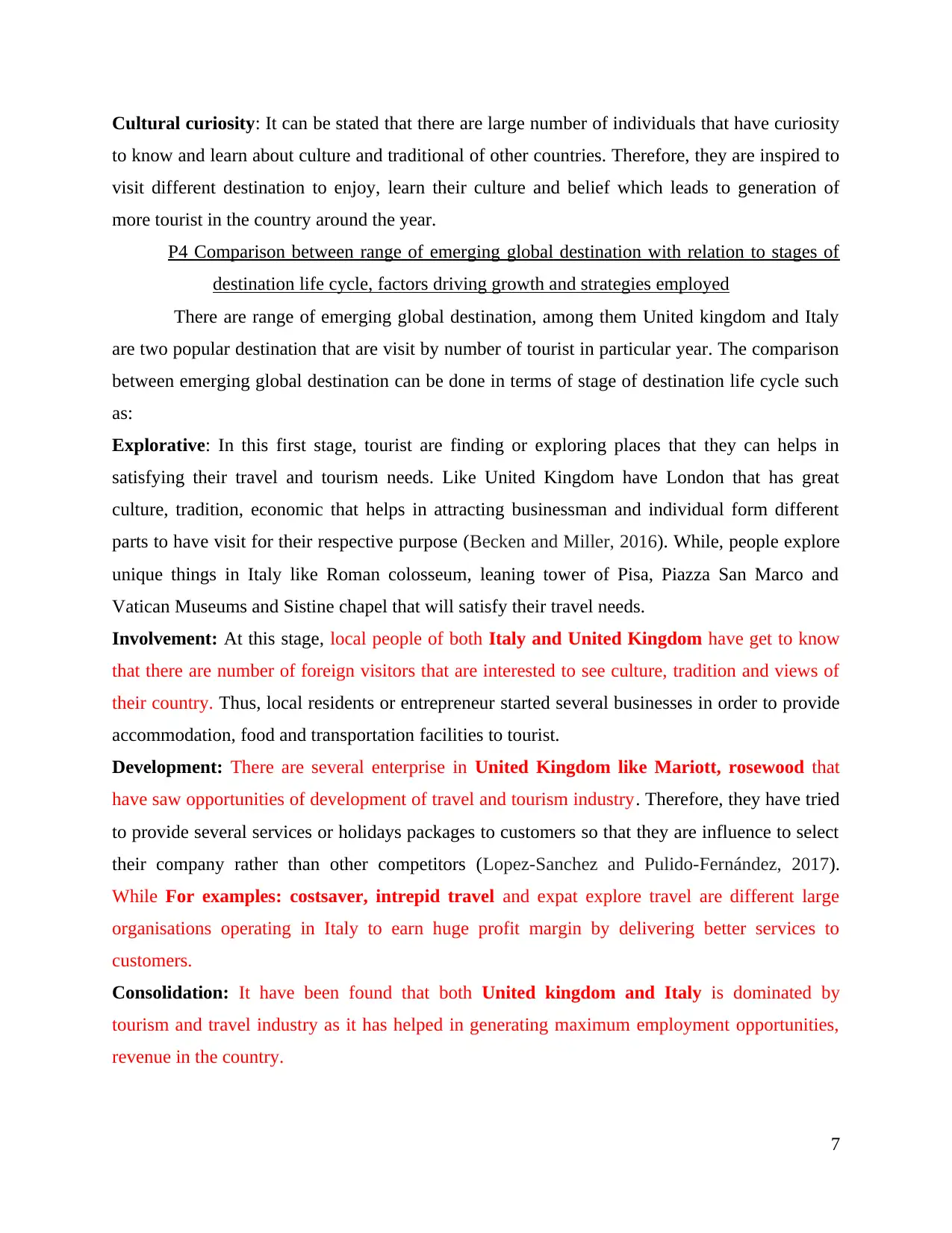
Cultural curiosity: It can be stated that there are large number of individuals that have curiosity
to know and learn about culture and traditional of other countries. Therefore, they are inspired to
visit different destination to enjoy, learn their culture and belief which leads to generation of
more tourist in the country around the year.
P4 Comparison between range of emerging global destination with relation to stages of
destination life cycle, factors driving growth and strategies employed
There are range of emerging global destination, among them United kingdom and Italy
are two popular destination that are visit by number of tourist in particular year. The comparison
between emerging global destination can be done in terms of stage of destination life cycle such
as:
Explorative: In this first stage, tourist are finding or exploring places that they can helps in
satisfying their travel and tourism needs. Like United Kingdom have London that has great
culture, tradition, economic that helps in attracting businessman and individual form different
parts to have visit for their respective purpose (Becken and Miller, 2016). While, people explore
unique things in Italy like Roman colosseum, leaning tower of Pisa, Piazza San Marco and
Vatican Museums and Sistine chapel that will satisfy their travel needs.
Involvement: At this stage, local people of both Italy and United Kingdom have get to know
that there are number of foreign visitors that are interested to see culture, tradition and views of
their country. Thus, local residents or entrepreneur started several businesses in order to provide
accommodation, food and transportation facilities to tourist.
Development: There are several enterprise in United Kingdom like Mariott, rosewood that
have saw opportunities of development of travel and tourism industry. Therefore, they have tried
to provide several services or holidays packages to customers so that they are influence to select
their company rather than other competitors (Lopez-Sanchez and Pulido-Fernández, 2017).
While For examples: costsaver, intrepid travel and expat explore travel are different large
organisations operating in Italy to earn huge profit margin by delivering better services to
customers.
Consolidation: It have been found that both United kingdom and Italy is dominated by
tourism and travel industry as it has helped in generating maximum employment opportunities,
revenue in the country.
7
to know and learn about culture and traditional of other countries. Therefore, they are inspired to
visit different destination to enjoy, learn their culture and belief which leads to generation of
more tourist in the country around the year.
P4 Comparison between range of emerging global destination with relation to stages of
destination life cycle, factors driving growth and strategies employed
There are range of emerging global destination, among them United kingdom and Italy
are two popular destination that are visit by number of tourist in particular year. The comparison
between emerging global destination can be done in terms of stage of destination life cycle such
as:
Explorative: In this first stage, tourist are finding or exploring places that they can helps in
satisfying their travel and tourism needs. Like United Kingdom have London that has great
culture, tradition, economic that helps in attracting businessman and individual form different
parts to have visit for their respective purpose (Becken and Miller, 2016). While, people explore
unique things in Italy like Roman colosseum, leaning tower of Pisa, Piazza San Marco and
Vatican Museums and Sistine chapel that will satisfy their travel needs.
Involvement: At this stage, local people of both Italy and United Kingdom have get to know
that there are number of foreign visitors that are interested to see culture, tradition and views of
their country. Thus, local residents or entrepreneur started several businesses in order to provide
accommodation, food and transportation facilities to tourist.
Development: There are several enterprise in United Kingdom like Mariott, rosewood that
have saw opportunities of development of travel and tourism industry. Therefore, they have tried
to provide several services or holidays packages to customers so that they are influence to select
their company rather than other competitors (Lopez-Sanchez and Pulido-Fernández, 2017).
While For examples: costsaver, intrepid travel and expat explore travel are different large
organisations operating in Italy to earn huge profit margin by delivering better services to
customers.
Consolidation: It have been found that both United kingdom and Italy is dominated by
tourism and travel industry as it has helped in generating maximum employment opportunities,
revenue in the country.
7
Paraphrase This Document
Need a fresh take? Get an instant paraphrase of this document with our AI Paraphraser
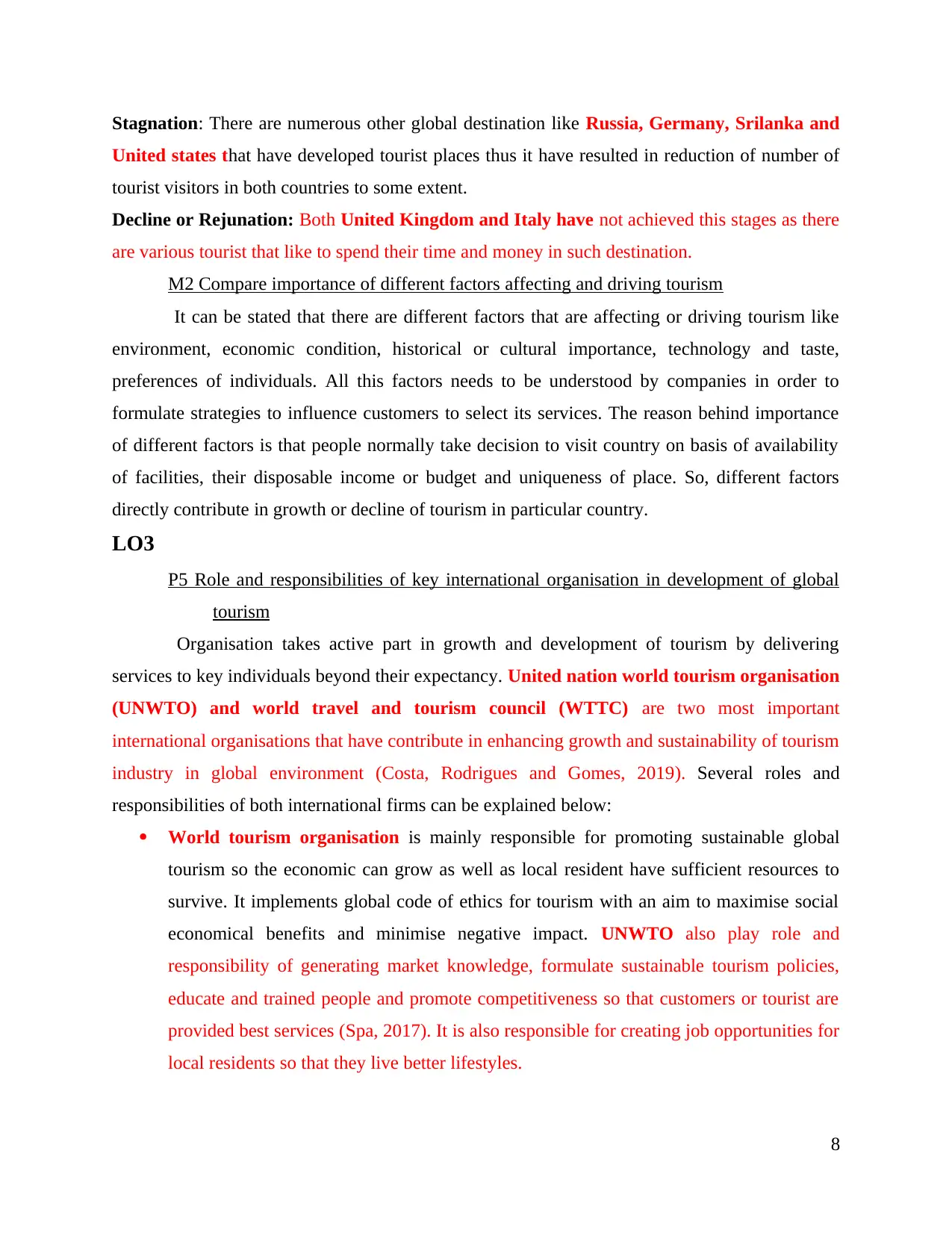
Stagnation: There are numerous other global destination like Russia, Germany, Srilanka and
United states that have developed tourist places thus it have resulted in reduction of number of
tourist visitors in both countries to some extent.
Decline or Rejunation: Both United Kingdom and Italy have not achieved this stages as there
are various tourist that like to spend their time and money in such destination.
M2 Compare importance of different factors affecting and driving tourism
It can be stated that there are different factors that are affecting or driving tourism like
environment, economic condition, historical or cultural importance, technology and taste,
preferences of individuals. All this factors needs to be understood by companies in order to
formulate strategies to influence customers to select its services. The reason behind importance
of different factors is that people normally take decision to visit country on basis of availability
of facilities, their disposable income or budget and uniqueness of place. So, different factors
directly contribute in growth or decline of tourism in particular country.
LO3
P5 Role and responsibilities of key international organisation in development of global
tourism
Organisation takes active part in growth and development of tourism by delivering
services to key individuals beyond their expectancy. United nation world tourism organisation
(UNWTO) and world travel and tourism council (WTTC) are two most important
international organisations that have contribute in enhancing growth and sustainability of tourism
industry in global environment (Costa, Rodrigues and Gomes, 2019). Several roles and
responsibilities of both international firms can be explained below:
World tourism organisation is mainly responsible for promoting sustainable global
tourism so the economic can grow as well as local resident have sufficient resources to
survive. It implements global code of ethics for tourism with an aim to maximise social
economical benefits and minimise negative impact. UNWTO also play role and
responsibility of generating market knowledge, formulate sustainable tourism policies,
educate and trained people and promote competitiveness so that customers or tourist are
provided best services (Spa, 2017). It is also responsible for creating job opportunities for
local residents so that they live better lifestyles.
8
United states that have developed tourist places thus it have resulted in reduction of number of
tourist visitors in both countries to some extent.
Decline or Rejunation: Both United Kingdom and Italy have not achieved this stages as there
are various tourist that like to spend their time and money in such destination.
M2 Compare importance of different factors affecting and driving tourism
It can be stated that there are different factors that are affecting or driving tourism like
environment, economic condition, historical or cultural importance, technology and taste,
preferences of individuals. All this factors needs to be understood by companies in order to
formulate strategies to influence customers to select its services. The reason behind importance
of different factors is that people normally take decision to visit country on basis of availability
of facilities, their disposable income or budget and uniqueness of place. So, different factors
directly contribute in growth or decline of tourism in particular country.
LO3
P5 Role and responsibilities of key international organisation in development of global
tourism
Organisation takes active part in growth and development of tourism by delivering
services to key individuals beyond their expectancy. United nation world tourism organisation
(UNWTO) and world travel and tourism council (WTTC) are two most important
international organisations that have contribute in enhancing growth and sustainability of tourism
industry in global environment (Costa, Rodrigues and Gomes, 2019). Several roles and
responsibilities of both international firms can be explained below:
World tourism organisation is mainly responsible for promoting sustainable global
tourism so the economic can grow as well as local resident have sufficient resources to
survive. It implements global code of ethics for tourism with an aim to maximise social
economical benefits and minimise negative impact. UNWTO also play role and
responsibility of generating market knowledge, formulate sustainable tourism policies,
educate and trained people and promote competitiveness so that customers or tourist are
provided best services (Spa, 2017). It is also responsible for creating job opportunities for
local residents so that they live better lifestyles.
8
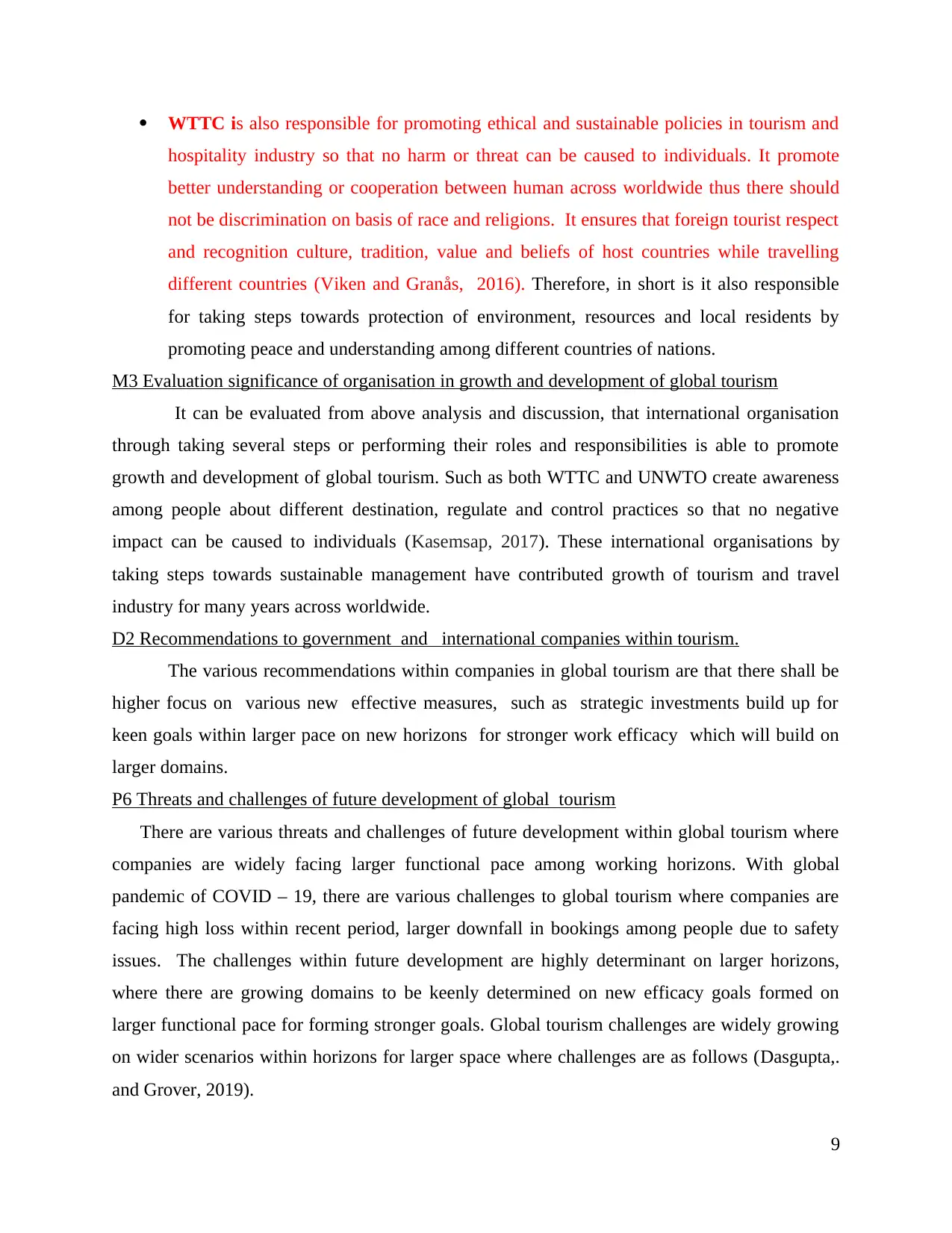
WTTC is also responsible for promoting ethical and sustainable policies in tourism and
hospitality industry so that no harm or threat can be caused to individuals. It promote
better understanding or cooperation between human across worldwide thus there should
not be discrimination on basis of race and religions. It ensures that foreign tourist respect
and recognition culture, tradition, value and beliefs of host countries while travelling
different countries (Viken and Granås, 2016). Therefore, in short is it also responsible
for taking steps towards protection of environment, resources and local residents by
promoting peace and understanding among different countries of nations.
M3 Evaluation significance of organisation in growth and development of global tourism
It can be evaluated from above analysis and discussion, that international organisation
through taking several steps or performing their roles and responsibilities is able to promote
growth and development of global tourism. Such as both WTTC and UNWTO create awareness
among people about different destination, regulate and control practices so that no negative
impact can be caused to individuals (Kasemsap, 2017). These international organisations by
taking steps towards sustainable management have contributed growth of tourism and travel
industry for many years across worldwide.
D2 Recommendations to government and international companies within tourism.
The various recommendations within companies in global tourism are that there shall be
higher focus on various new effective measures, such as strategic investments build up for
keen goals within larger pace on new horizons for stronger work efficacy which will build on
larger domains.
P6 Threats and challenges of future development of global tourism
There are various threats and challenges of future development within global tourism where
companies are widely facing larger functional pace among working horizons. With global
pandemic of COVID – 19, there are various challenges to global tourism where companies are
facing high loss within recent period, larger downfall in bookings among people due to safety
issues. The challenges within future development are highly determinant on larger horizons,
where there are growing domains to be keenly determined on new efficacy goals formed on
larger functional pace for forming stronger goals. Global tourism challenges are widely growing
on wider scenarios within horizons for larger space where challenges are as follows (Dasgupta,.
and Grover, 2019).
9
hospitality industry so that no harm or threat can be caused to individuals. It promote
better understanding or cooperation between human across worldwide thus there should
not be discrimination on basis of race and religions. It ensures that foreign tourist respect
and recognition culture, tradition, value and beliefs of host countries while travelling
different countries (Viken and Granås, 2016). Therefore, in short is it also responsible
for taking steps towards protection of environment, resources and local residents by
promoting peace and understanding among different countries of nations.
M3 Evaluation significance of organisation in growth and development of global tourism
It can be evaluated from above analysis and discussion, that international organisation
through taking several steps or performing their roles and responsibilities is able to promote
growth and development of global tourism. Such as both WTTC and UNWTO create awareness
among people about different destination, regulate and control practices so that no negative
impact can be caused to individuals (Kasemsap, 2017). These international organisations by
taking steps towards sustainable management have contributed growth of tourism and travel
industry for many years across worldwide.
D2 Recommendations to government and international companies within tourism.
The various recommendations within companies in global tourism are that there shall be
higher focus on various new effective measures, such as strategic investments build up for
keen goals within larger pace on new horizons for stronger work efficacy which will build on
larger domains.
P6 Threats and challenges of future development of global tourism
There are various threats and challenges of future development within global tourism where
companies are widely facing larger functional pace among working horizons. With global
pandemic of COVID – 19, there are various challenges to global tourism where companies are
facing high loss within recent period, larger downfall in bookings among people due to safety
issues. The challenges within future development are highly determinant on larger horizons,
where there are growing domains to be keenly determined on new efficacy goals formed on
larger functional pace for forming stronger goals. Global tourism challenges are widely growing
on wider scenarios within horizons for larger space where challenges are as follows (Dasgupta,.
and Grover, 2019).
9
⊘ This is a preview!⊘
Do you want full access?
Subscribe today to unlock all pages.

Trusted by 1+ million students worldwide
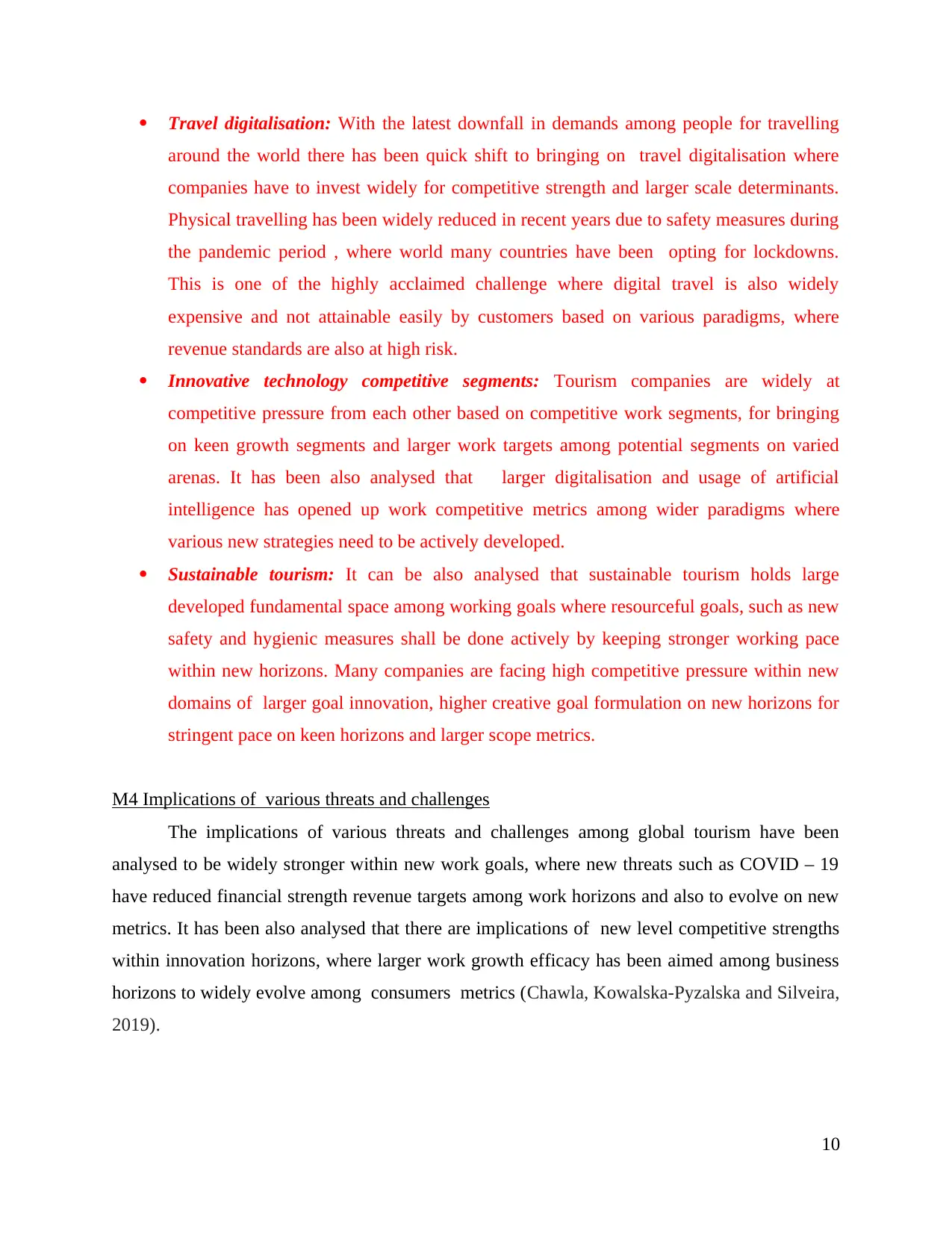
Travel digitalisation: With the latest downfall in demands among people for travelling
around the world there has been quick shift to bringing on travel digitalisation where
companies have to invest widely for competitive strength and larger scale determinants.
Physical travelling has been widely reduced in recent years due to safety measures during
the pandemic period , where world many countries have been opting for lockdowns.
This is one of the highly acclaimed challenge where digital travel is also widely
expensive and not attainable easily by customers based on various paradigms, where
revenue standards are also at high risk.
Innovative technology competitive segments: Tourism companies are widely at
competitive pressure from each other based on competitive work segments, for bringing
on keen growth segments and larger work targets among potential segments on varied
arenas. It has been also analysed that larger digitalisation and usage of artificial
intelligence has opened up work competitive metrics among wider paradigms where
various new strategies need to be actively developed.
Sustainable tourism: It can be also analysed that sustainable tourism holds large
developed fundamental space among working goals where resourceful goals, such as new
safety and hygienic measures shall be done actively by keeping stronger working pace
within new horizons. Many companies are facing high competitive pressure within new
domains of larger goal innovation, higher creative goal formulation on new horizons for
stringent pace on keen horizons and larger scope metrics.
M4 Implications of various threats and challenges
The implications of various threats and challenges among global tourism have been
analysed to be widely stronger within new work goals, where new threats such as COVID – 19
have reduced financial strength revenue targets among work horizons and also to evolve on new
metrics. It has been also analysed that there are implications of new level competitive strengths
within innovation horizons, where larger work growth efficacy has been aimed among business
horizons to widely evolve among consumers metrics (Chawla, Kowalska-Pyzalska and Silveira,
2019).
10
around the world there has been quick shift to bringing on travel digitalisation where
companies have to invest widely for competitive strength and larger scale determinants.
Physical travelling has been widely reduced in recent years due to safety measures during
the pandemic period , where world many countries have been opting for lockdowns.
This is one of the highly acclaimed challenge where digital travel is also widely
expensive and not attainable easily by customers based on various paradigms, where
revenue standards are also at high risk.
Innovative technology competitive segments: Tourism companies are widely at
competitive pressure from each other based on competitive work segments, for bringing
on keen growth segments and larger work targets among potential segments on varied
arenas. It has been also analysed that larger digitalisation and usage of artificial
intelligence has opened up work competitive metrics among wider paradigms where
various new strategies need to be actively developed.
Sustainable tourism: It can be also analysed that sustainable tourism holds large
developed fundamental space among working goals where resourceful goals, such as new
safety and hygienic measures shall be done actively by keeping stronger working pace
within new horizons. Many companies are facing high competitive pressure within new
domains of larger goal innovation, higher creative goal formulation on new horizons for
stringent pace on keen horizons and larger scope metrics.
M4 Implications of various threats and challenges
The implications of various threats and challenges among global tourism have been
analysed to be widely stronger within new work goals, where new threats such as COVID – 19
have reduced financial strength revenue targets among work horizons and also to evolve on new
metrics. It has been also analysed that there are implications of new level competitive strengths
within innovation horizons, where larger work growth efficacy has been aimed among business
horizons to widely evolve among consumers metrics (Chawla, Kowalska-Pyzalska and Silveira,
2019).
10
Paraphrase This Document
Need a fresh take? Get an instant paraphrase of this document with our AI Paraphraser
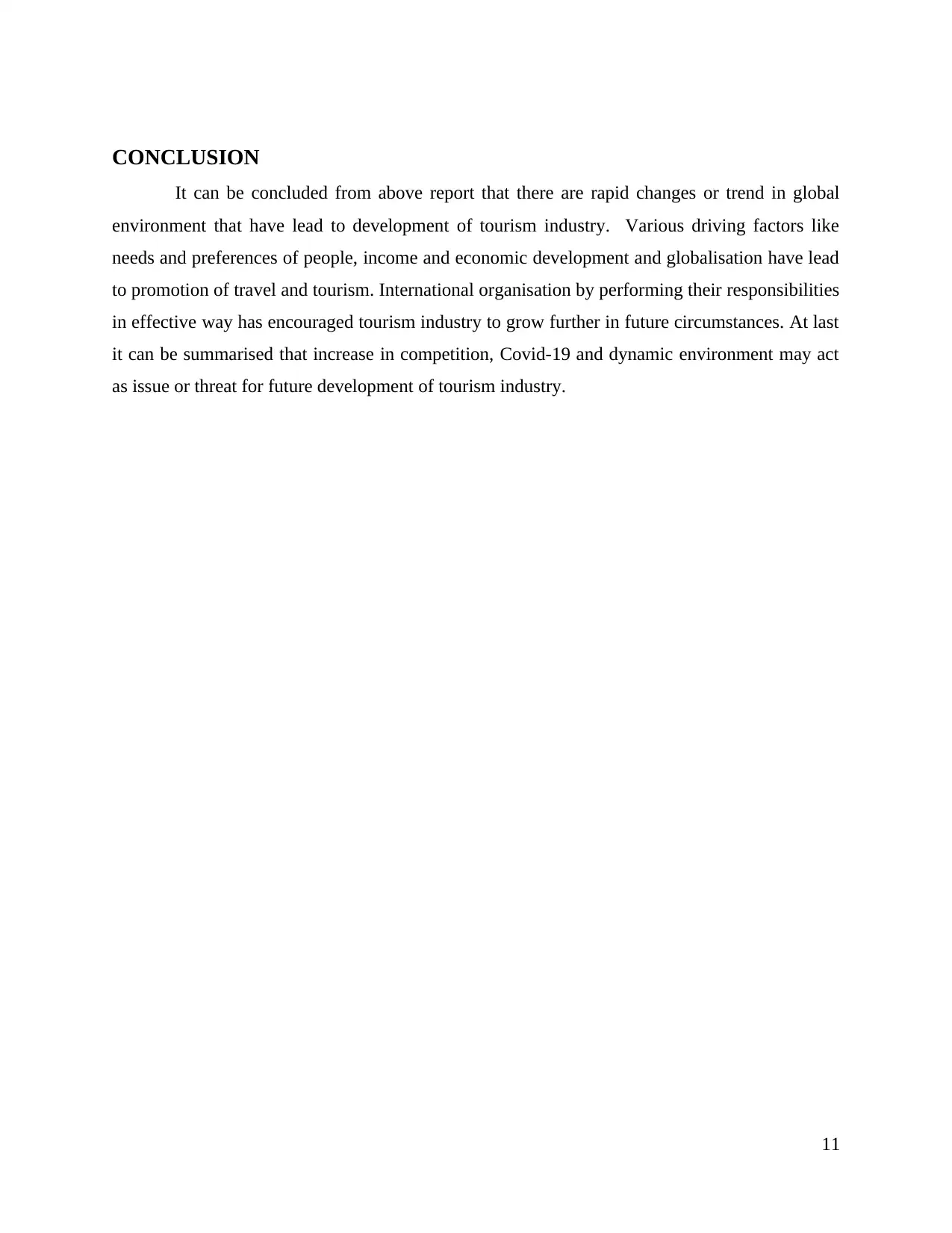
CONCLUSION
It can be concluded from above report that there are rapid changes or trend in global
environment that have lead to development of tourism industry. Various driving factors like
needs and preferences of people, income and economic development and globalisation have lead
to promotion of travel and tourism. International organisation by performing their responsibilities
in effective way has encouraged tourism industry to grow further in future circumstances. At last
it can be summarised that increase in competition, Covid-19 and dynamic environment may act
as issue or threat for future development of tourism industry.
11
It can be concluded from above report that there are rapid changes or trend in global
environment that have lead to development of tourism industry. Various driving factors like
needs and preferences of people, income and economic development and globalisation have lead
to promotion of travel and tourism. International organisation by performing their responsibilities
in effective way has encouraged tourism industry to grow further in future circumstances. At last
it can be summarised that increase in competition, Covid-19 and dynamic environment may act
as issue or threat for future development of tourism industry.
11
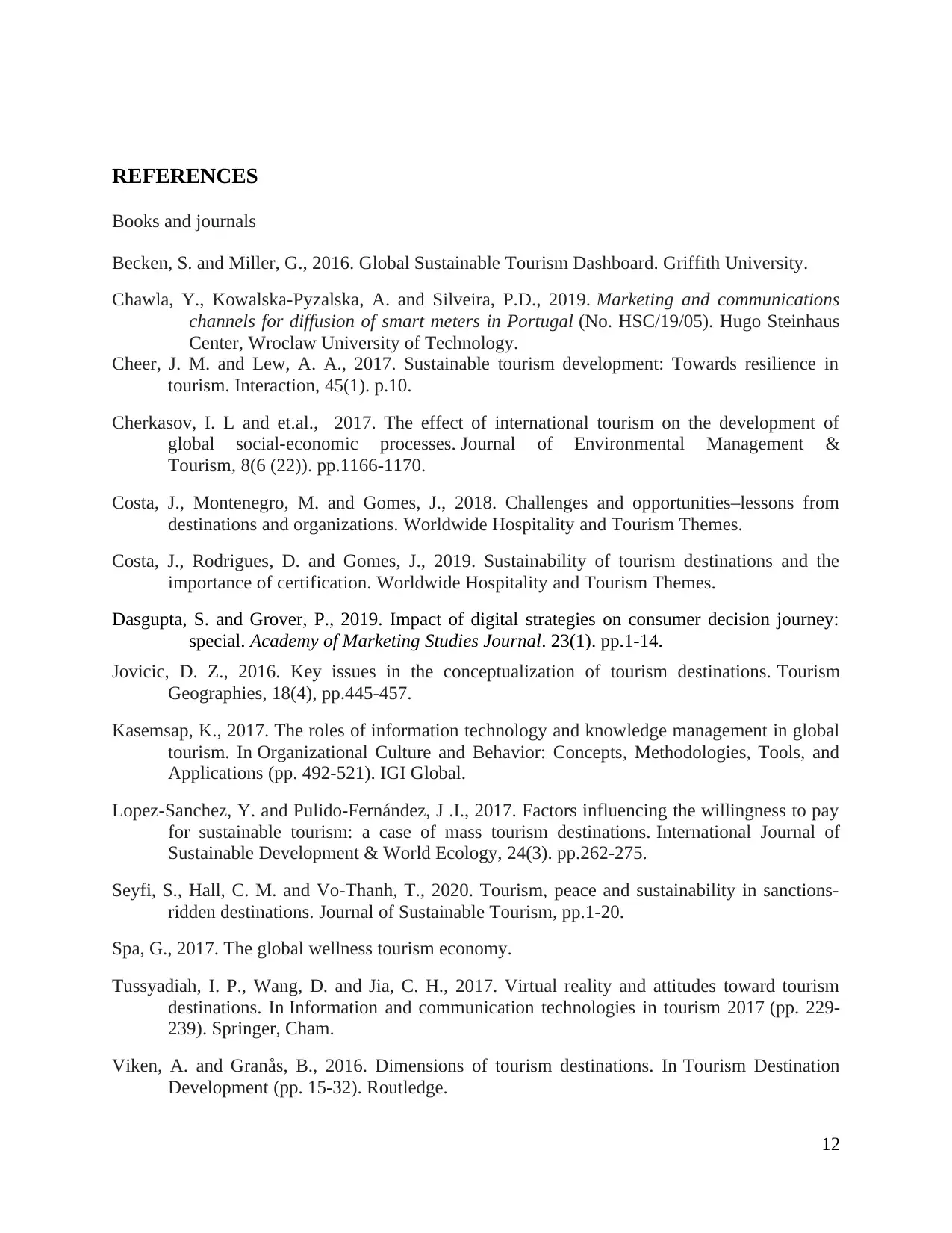
REFERENCES
Books and journals
Becken, S. and Miller, G., 2016. Global Sustainable Tourism Dashboard. Griffith University.
Chawla, Y., Kowalska-Pyzalska, A. and Silveira, P.D., 2019. Marketing and communications
channels for diffusion of smart meters in Portugal (No. HSC/19/05). Hugo Steinhaus
Center, Wroclaw University of Technology.
Cheer, J. M. and Lew, A. A., 2017. Sustainable tourism development: Towards resilience in
tourism. Interaction, 45(1). p.10.
Cherkasov, I. L and et.al., 2017. The effect of international tourism on the development of
global social-economic processes. Journal of Environmental Management &
Tourism, 8(6 (22)). pp.1166-1170.
Costa, J., Montenegro, M. and Gomes, J., 2018. Challenges and opportunities–lessons from
destinations and organizations. Worldwide Hospitality and Tourism Themes.
Costa, J., Rodrigues, D. and Gomes, J., 2019. Sustainability of tourism destinations and the
importance of certification. Worldwide Hospitality and Tourism Themes.
Dasgupta, S. and Grover, P., 2019. Impact of digital strategies on consumer decision journey:
special. Academy of Marketing Studies Journal. 23(1). pp.1-14.
Jovicic, D. Z., 2016. Key issues in the conceptualization of tourism destinations. Tourism
Geographies, 18(4), pp.445-457.
Kasemsap, K., 2017. The roles of information technology and knowledge management in global
tourism. In Organizational Culture and Behavior: Concepts, Methodologies, Tools, and
Applications (pp. 492-521). IGI Global.
Lopez-Sanchez, Y. and Pulido-Fernández, J .I., 2017. Factors influencing the willingness to pay
for sustainable tourism: a case of mass tourism destinations. International Journal of
Sustainable Development & World Ecology, 24(3). pp.262-275.
Seyfi, S., Hall, C. M. and Vo-Thanh, T., 2020. Tourism, peace and sustainability in sanctions-
ridden destinations. Journal of Sustainable Tourism, pp.1-20.
Spa, G., 2017. The global wellness tourism economy.
Tussyadiah, I. P., Wang, D. and Jia, C. H., 2017. Virtual reality and attitudes toward tourism
destinations. In Information and communication technologies in tourism 2017 (pp. 229-
239). Springer, Cham.
Viken, A. and Granås, B., 2016. Dimensions of tourism destinations. In Tourism Destination
Development (pp. 15-32). Routledge.
12
Books and journals
Becken, S. and Miller, G., 2016. Global Sustainable Tourism Dashboard. Griffith University.
Chawla, Y., Kowalska-Pyzalska, A. and Silveira, P.D., 2019. Marketing and communications
channels for diffusion of smart meters in Portugal (No. HSC/19/05). Hugo Steinhaus
Center, Wroclaw University of Technology.
Cheer, J. M. and Lew, A. A., 2017. Sustainable tourism development: Towards resilience in
tourism. Interaction, 45(1). p.10.
Cherkasov, I. L and et.al., 2017. The effect of international tourism on the development of
global social-economic processes. Journal of Environmental Management &
Tourism, 8(6 (22)). pp.1166-1170.
Costa, J., Montenegro, M. and Gomes, J., 2018. Challenges and opportunities–lessons from
destinations and organizations. Worldwide Hospitality and Tourism Themes.
Costa, J., Rodrigues, D. and Gomes, J., 2019. Sustainability of tourism destinations and the
importance of certification. Worldwide Hospitality and Tourism Themes.
Dasgupta, S. and Grover, P., 2019. Impact of digital strategies on consumer decision journey:
special. Academy of Marketing Studies Journal. 23(1). pp.1-14.
Jovicic, D. Z., 2016. Key issues in the conceptualization of tourism destinations. Tourism
Geographies, 18(4), pp.445-457.
Kasemsap, K., 2017. The roles of information technology and knowledge management in global
tourism. In Organizational Culture and Behavior: Concepts, Methodologies, Tools, and
Applications (pp. 492-521). IGI Global.
Lopez-Sanchez, Y. and Pulido-Fernández, J .I., 2017. Factors influencing the willingness to pay
for sustainable tourism: a case of mass tourism destinations. International Journal of
Sustainable Development & World Ecology, 24(3). pp.262-275.
Seyfi, S., Hall, C. M. and Vo-Thanh, T., 2020. Tourism, peace and sustainability in sanctions-
ridden destinations. Journal of Sustainable Tourism, pp.1-20.
Spa, G., 2017. The global wellness tourism economy.
Tussyadiah, I. P., Wang, D. and Jia, C. H., 2017. Virtual reality and attitudes toward tourism
destinations. In Information and communication technologies in tourism 2017 (pp. 229-
239). Springer, Cham.
Viken, A. and Granås, B., 2016. Dimensions of tourism destinations. In Tourism Destination
Development (pp. 15-32). Routledge.
12
⊘ This is a preview!⊘
Do you want full access?
Subscribe today to unlock all pages.

Trusted by 1+ million students worldwide
1 out of 13
Related Documents
Your All-in-One AI-Powered Toolkit for Academic Success.
+13062052269
info@desklib.com
Available 24*7 on WhatsApp / Email
![[object Object]](/_next/static/media/star-bottom.7253800d.svg)
Unlock your academic potential
Copyright © 2020–2025 A2Z Services. All Rights Reserved. Developed and managed by ZUCOL.



